Mohangic Acid H and Mohangiol: New p-Aminoacetophenone Derivatives from a Mudflat-Derived Streptomyces sp.
Abstract
1. Introduction
2. Results and Discussion
2.1. Structural Elucidation

2.2. Proposed Biosynthetic Pathway of Mohangic Acids
2.3. Bioinformatic Analysis for Stereochemical Assignment
2.4. Biological Evaluation
3. Materials and Methods
3.1. General Experimental Procedures
3.2. Bacterial Isolation
3.3. Identification and Classification of the Strain
3.4. Cultivation and Extraction
3.5. Isolation of Mohangic Acid H (1) and Mohangiol (2)
3.6. Conformational Search and DP4+ Analysis
3.7. Sequencing and Gene Annotation
3.8. Bioinformatic Analysis
3.9. Antibacterial Activity Assay
3.10. Antifungal Activity Assay
3.11. Isocitrate Lyase (ICL) Activity Assay
4. Conclusions
Supplementary Materials
Author Contributions
Funding
Institutional Review Board Statement
Data Availability Statement
Conflicts of Interest
References
- Jose, P.A.; Jha, B. Intertidal Marine Sediment Harbours Actinobacteria with Promising Bioactive and Biosynthetic Potential. Sci. Rep. 2017, 7, 10041. [Google Scholar] [CrossRef]
- Ryu, D.; Hillman, P.F.; Akinniyi, G.; Nam, S.-J.; Yang, I. Marine Mudflat Actinomycetes as a Novel Natural Products Source. Front. Mar. Sci. 2023, 10, 1297446. [Google Scholar] [CrossRef]
- Donald, L.; Pipite, A.; Subramani, R.; Owen, J.; Keyzers, R.A.; Taufa, T. Streptomyces: Still the Biggest Producer of New Natural Secondary Metabolites, a Current Perspective. Microbiol. Res. 2022, 13, 418–465. [Google Scholar] [CrossRef]
- Nett, M.; Ikeda, H.; Moore, B.S. Genomic Basis for Natural Product Biosynthetic Diversity in the Actinomycetes. Nat. Prod. Rep. 2009, 26, 1362–1384. [Google Scholar] [CrossRef] [PubMed]
- Chen, J.; Zhang, P.; Ye, X.; Wei, B.; Emam, M.; Zhang, H.; Wang, H. The Structural Diversity of Marine Microbial Secondary Metabolites Based on Co-Culture Strategy: 2009–2019. Mar. Drugs 2020, 18, 449. [Google Scholar] [CrossRef] [PubMed]
- Srinivasan, R.; Kannappan, A.; Shi, C.; Lin, X. Marine Bacterial Secondary Metabolites: A Treasure House for Structurally Unique and Effective Antimicrobial Compounds. Mar. Drugs 2021, 19, 530. [Google Scholar] [CrossRef]
- Jeong, H.; Jo, S.J.; Bae, M.; Kim, Y.R.; Moon, K. Actinoflavosides B-D, Flavonoid Type Glycosides from Tidal Mudflat-Derived Actinomyces. Mar. Drugs 2022, 20, 565. [Google Scholar] [CrossRef]
- Bae, M.; Chung, B.; Oh, K.-B.; Shin, J.; Oh, D.-C. Hormaomycins B and C: New Antibiotic Cyclic Depsipeptides from a Marine Mudflat-Derived Streptomyces sp. Mar. Drugs 2015, 13, 5187–5200. [Google Scholar] [CrossRef]
- Bae, M.; Kim, H.; Moon, K.; Nam, S.-J.; Shin, J.; Oh, K.-B.; Oh, D.-C. Mohangamides A and B, New Dilactone-Tethered Pseudo-Dimeric Peptides Inhibiting Candida albicans Isocitrate Lyase. Org. Lett. 2015, 17, 712–715. [Google Scholar] [CrossRef]
- Bae, M.; Oh, J.; Bae, E.S.; Oh, J.; Hur, J.; Suh, Y.-G.; Lee, S.K.; Shin, J.; Oh, D.-C. WS9326H, an Antiangiogenic Pyrazolone-Bearing Peptide from an Intertidal Mudflat Actinomycete. Org. Lett. 2018, 20, 1999–2002. [Google Scholar] [CrossRef]
- Bae, M.; Moon, K.; Kim, J.; Park, H.J.; Lee, S.K.; Shin, J.; Oh, D.-C. Mohangic Acids A–E, p-Aminoacetophenonic Acids from a Marine-Mudflat-Derived Streptomyces Sp. J. Nat. Prod. 2016, 79, 332–339. [Google Scholar] [CrossRef]
- Zhao, H.W.; Yi, Y.; Li, J.Q.; Wang, J.H. Two New Mohangic Acid Derivatives from the Deep-Sea Bacteria Alcanivorax dieselolei BC-5. Nat. Prod. Res. 2024, 38, 206–210. [Google Scholar] [CrossRef]
- Waksman, S.A.; Lechevalier, H.A.; Schaffner, C.P. Candicidin and Other Polyenic Antifungal Antibiotics. Bull. World Health Organ. 1965, 33, 219–226. [Google Scholar]
- Zanardi, M.M.; Sarotti, A.M. Sensitivity Analysis of DP4+ with the Probability Distribution Terms: Development of a Universal and Customizable Method. J. Org. Chem. 2021, 86, 8544–8548. [Google Scholar] [CrossRef] [PubMed]
- Blin, K.; Shaw, S.; Vader, L.; Szenei, J.; Reitz, Z.L.; Augustijn, H.E.; Cediel-Becerra, J.D.D.; de Crécy-Lagard, V.; Koetsier, R.A.; Williams, S.E.; et al. antiSMASH 8.0: Extended Gene Cluster Detection Capabilities and Analyses of Chemistry, Enzymology, and Regulation. Nucleic Acids Res. 2025, 53, W32–W38. [Google Scholar] [CrossRef] [PubMed]
- Gil, J.; Campelo-Diez, A. Candicidin Biosynthesis in Streptomyces griseus. Appl. Microbiol. Biotechnol. 2003, 60, 633–642. [Google Scholar] [CrossRef] [PubMed]
- Campelo, A.B.; Gil, J.A. The candicidin gene cluster from Streptomyces griseus IMRU 3570. Microbiology 2002, 148, 51–59. [Google Scholar] [CrossRef][Green Version]
- Chen, S.; Huang, X.; Zhou, X.; Bai, L.; He, J.; Jeong, K.J.; Lee, S.Y.; Deng, Z. Organizational and Mutational Analysis of a Complete FR-008/Candicidin Gene Cluster Encoding a Structurally Related Polyene Complex. Chem. Biol. 2003, 10, 1065–1076. [Google Scholar] [CrossRef]
- Lei, X.; Kong, L.; Zhang, C.; Liu, Q.; Yao, F.; Zhang, W.; Deng, Z.; You, D. In Vivo Investigation of the Substrate Recognition Capability and Activity Affecting Amino Acid Residues of Glycosyltransferase FscMI in the Biosynthesis of Candicidin. Mol. Biosyst. 2013, 9, 422–430. [Google Scholar] [CrossRef]
- Asturias, J.A.; Liras, P.; Martín, J.F. Phosphate Control of pabS Gene Transcription during Candicidin Biosynthesis. Gene 1990, 93, 79–84. [Google Scholar] [CrossRef]
- Chen, S.; Mao, X.; Shen, Y.; Zhou, Y.; Li, J.; Wang, L.; Tao, X.; Yang, L.; Wang, Y.; Zhou, X.; et al. Tailoring the P450 Monooxygenase Gene for FR-008/Candicidin Biosynthesis. Appl. Environ. Microbiol. 2009, 75, 1778–1781. [Google Scholar] [CrossRef]
- Kavanagh, K.L.; Jörnvall, H.; Persson, B.; Oppermann, U. Medium- and Short-Chain Dehydrogenase/Reductase Gene and Protein Families. Cell. Mol. Life Sci. 2008, 65, 3895. [Google Scholar] [CrossRef]
- Lee, B.I.; Suh, S.W. Crystal Structure of the Schiff Base Intermediate Prior to Decarboxylation in the Catalytic Cycle of Aspartate α-Decarboxylase. J. Mol. Biol. 2004, 340, 1–7. [Google Scholar] [CrossRef]
- Liang, C.; Nie, Y.; Mu, X.; Xu, Y. Gene Mining-Based Identification of Aldo–Keto Reductases for Highly Stereoselective Reduction of Bulky Ketones. Bioresour. Bioprocess. 2018, 5, 33. [Google Scholar] [CrossRef]
- Huang, H.; Grove, A. The Transcriptional Regulator TamR from Streptomyces coelicolor Controls a Key Step in Central Metabolism during Oxidative Stress. Mol. Microbiol. 2013, 87, 1151–1166. [Google Scholar] [CrossRef] [PubMed]
- Burckhardt, R.M.; Escalante-Semerena, J.C. Small-Molecule Acetylation by GCN5-Related N-Acetyltransferases in Bacteria. Microbiol. Mol. Biol. Rev. 2020, 84, e00090-19. [Google Scholar] [CrossRef] [PubMed]
- Caffrey, P. Conserved Amino Acid Residues Correlating With Ketoreductase Stereospecificity in Modular Polyketide Synthases. ChemBioChem 2003, 4, 654–657. [Google Scholar] [CrossRef]
- Keatinge-Clay, A.T. A Tylosin Ketoreductase Reveals How Chirality Is Determined in Polyketides. Chem. Biol. 2007, 14, 898–908. [Google Scholar] [CrossRef]
- Xiang, C.; Yao, S.; Wang, R.; Zhang, L. Bioinformatic Prediction of the Stereoselectivity of Modular Polyketide Synthase: An Update of the Sequence Motifs in Ketoreductase Domain. Beilstein J. Org. Chem. 2024, 20, 1476–1485. [Google Scholar] [CrossRef]
- Takahashi, K.; Kudo, S.; Kawamura, K.; Kusakabe, T.; Kikkawa, S.; Azumaya, I.; Kato, K. Synthesis of the Proposed Structure of Mohangic Acid C. Org. Lett. 2022, 24, 3416–3420. [Google Scholar] [CrossRef]
- Hernández-Chinea, C.; Maimone, L.; Campos, Y.; Mosca, W.; Romero, P.J. Apparent Isocitrate Lyase Activity in Leishmania amazonensis. Acta. Parasitol. 2017, 62, 701–707. [Google Scholar] [CrossRef] [PubMed]
- Khanojia, G.; Walhekar, V.; Ashwini, P.; Birajdar, P.; Ritesh, P.; Muthal, A.; Bodhankar, S.; Bagul, C.; Kumar, D.; Macha, B.; et al. Deciphering Molecular Insights into Isocitrate Lyase and Their Inhibitors: A Detailed Display through Medicinal Chemistry Window. Indian J. Pharm. Educ. Res. 2025, 59, 453–471. [Google Scholar] [CrossRef]
- Langridge, S.J.; Baker, P.J.; De Lucas, J.R.; Sedelnikova, S.E.; Turner, G.; Rice, D.W. Isocitrate Lyase from Aspergillus nidulans: Crystallization and X-Ray Analysis of a Glyoxylate Cycle Enzyme. Acta Crystallogr. D 1997, 53, 488–490. [Google Scholar] [CrossRef]
- Bhusal, R.P.; Bashiri, G.; Kwai, B.X.C.; Sperry, J.; Leung, I.K.H. Targeting Isocitrate Lyase for the Treatment of Latent Tuberculosis. Drug Discov. Today 2017, 22, 1008–1016. [Google Scholar] [CrossRef] [PubMed]
- Figueroa-Bossi, N.; Balbontín, R.; Bossi, L. Preparing Plasmid DNA from Bacteria. Cold Spring Harb. Protoc. 2022, 2022, Pdb.prot107852. [Google Scholar] [CrossRef]
- Wick, R.R.; Judd, L.M.; Gorrie, C.L.; Holt, K.E. Unicycler: Resolving Bacterial Genome Assemblies from Short and Long Sequencing Reads. PLoS Comput. Biol. 2017, 13, e1005595. [Google Scholar] [CrossRef]
- Seemann, T. Prokka: Rapid Prokaryotic Genome Annotation. Bioinformatics 2014, 30, 2068–2069. [Google Scholar] [CrossRef]
- Zdouc, M.M.; Blin, K.; Louwen, N.L.L.; Navarro, J.; Loureiro, C.; Bader, C.D.; Bailey, C.B.; Barra, L.; Booth, T.J.; Bozhüyük, K.A.J.; et al. MIBiG 4.0: Advancing Biosynthetic Gene Cluster Curation through Global Collaboration. Nucleic Acids Res. 2025, 53, D678–D690. [Google Scholar] [CrossRef]
- Kumar, S.; Stecher, G.; Suleski, M.; Sanderford, M.; Sharma, S.; Tamura, K. MEGA12: Molecular Evolutionary Genetic Analysis Version 12 for Adaptive and Green Computing. Mol. Biol. Evol. 2024, 41, msae263. [Google Scholar] [CrossRef]
- Edgar, R.C. MUSCLE: A Multiple Sequence Alignment Method with Reduced Time and Space Complexity. BMC Bioinform. 2004, 5, 113. [Google Scholar] [CrossRef]
- Crooks, G.E.; Hon, G.; Chandonia, J.-M.; Brenner, S.E. WebLogo: A Sequence Logo Generator. Genome Res. 2004, 14, 1188–1190. [Google Scholar] [CrossRef]
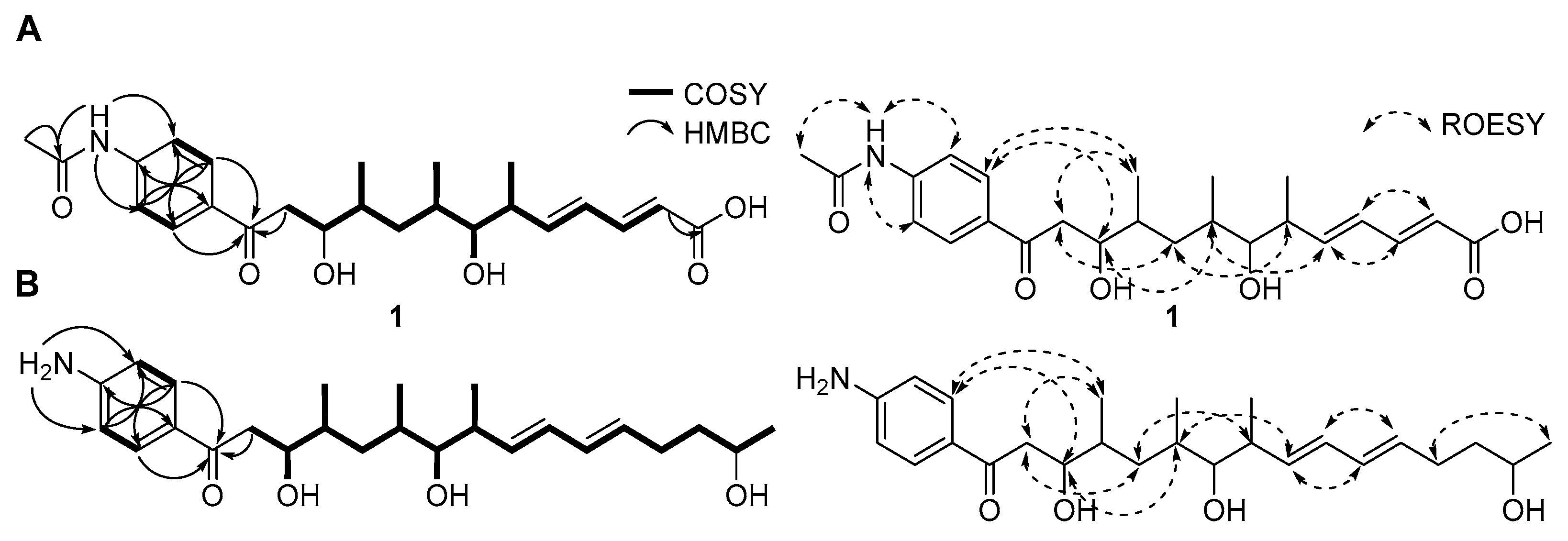
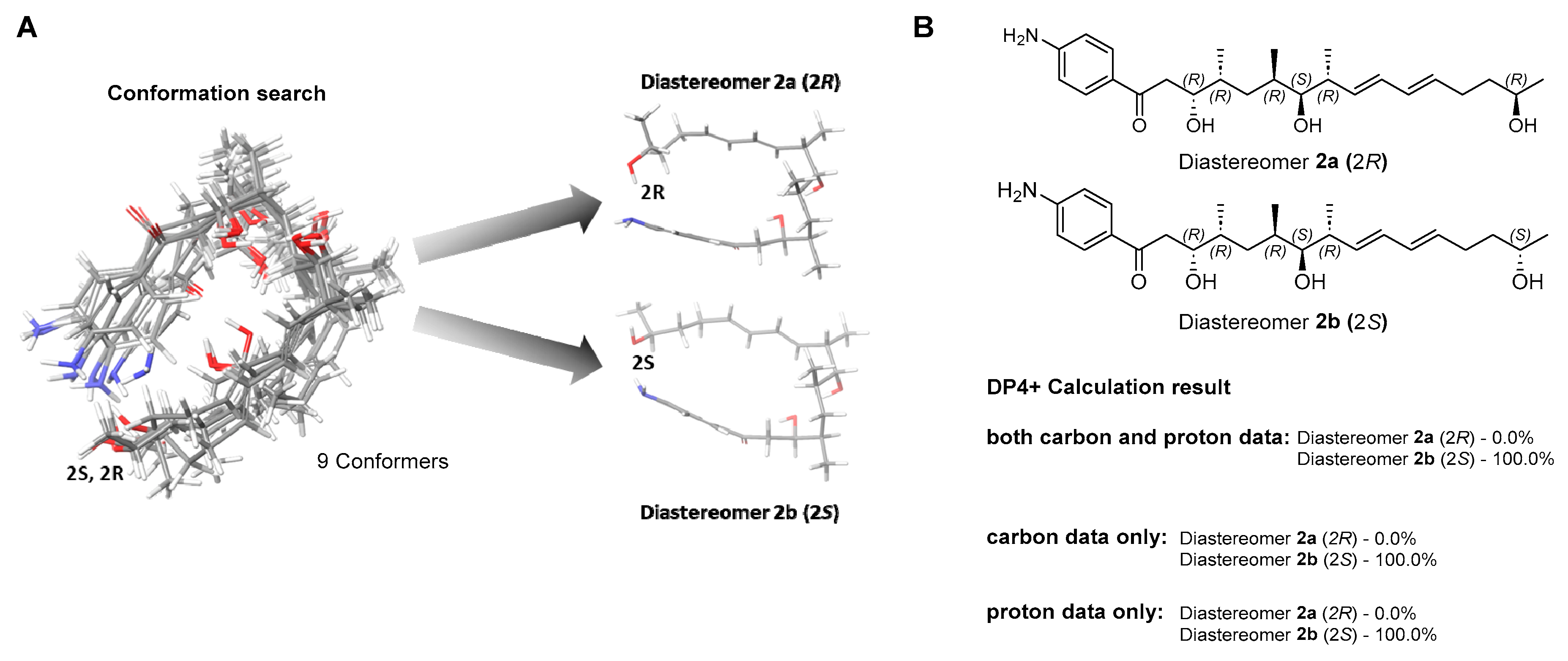
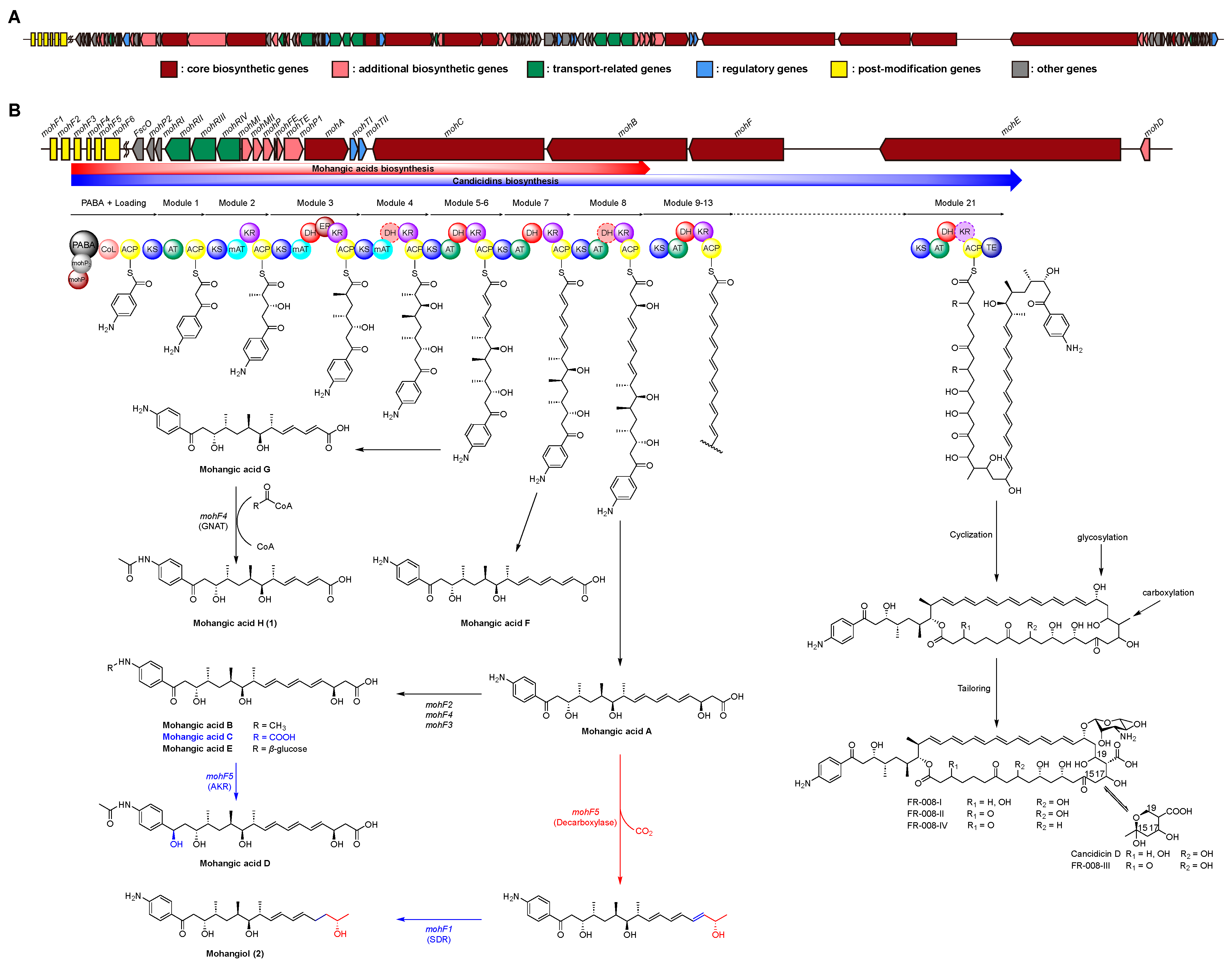
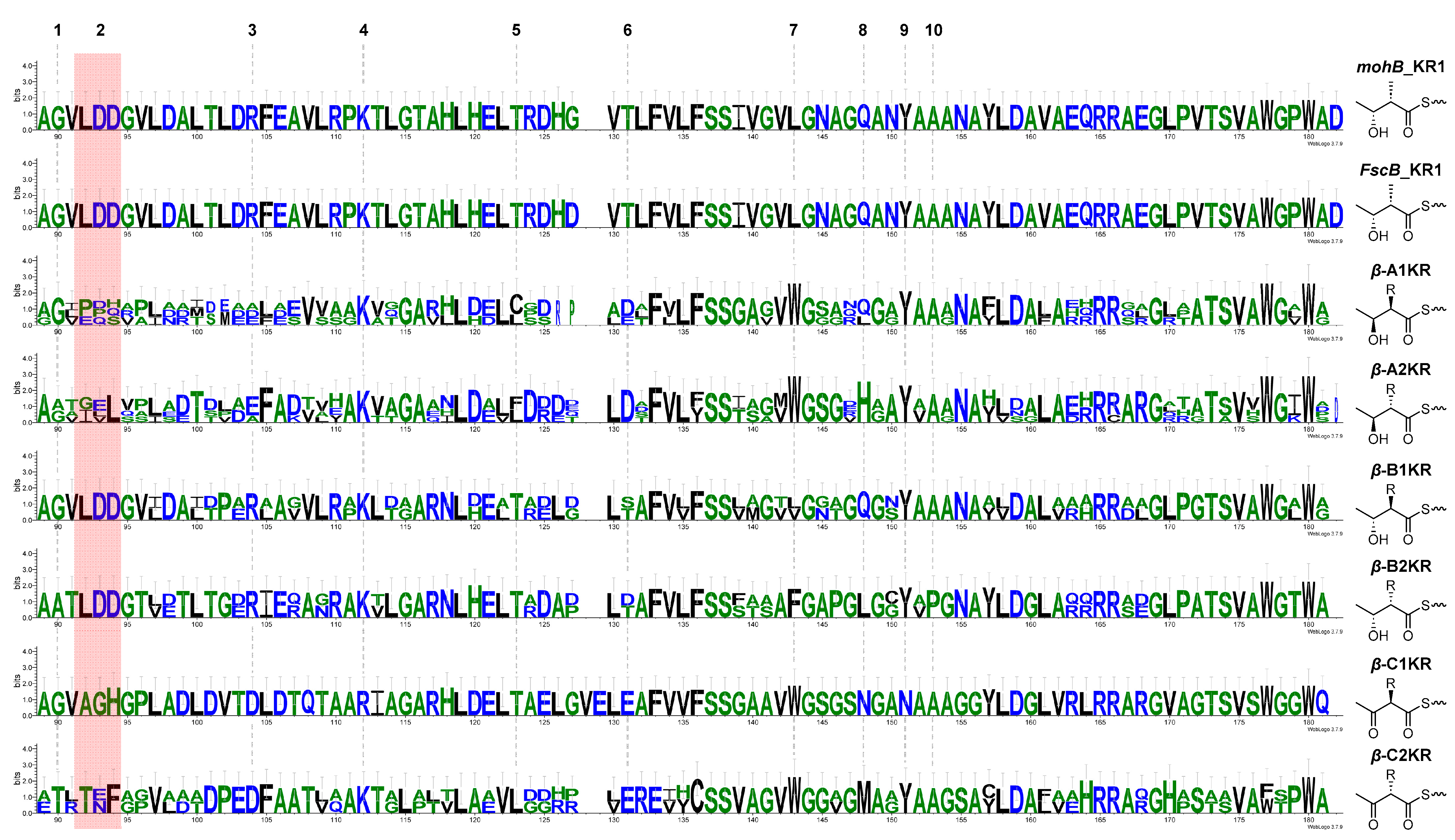
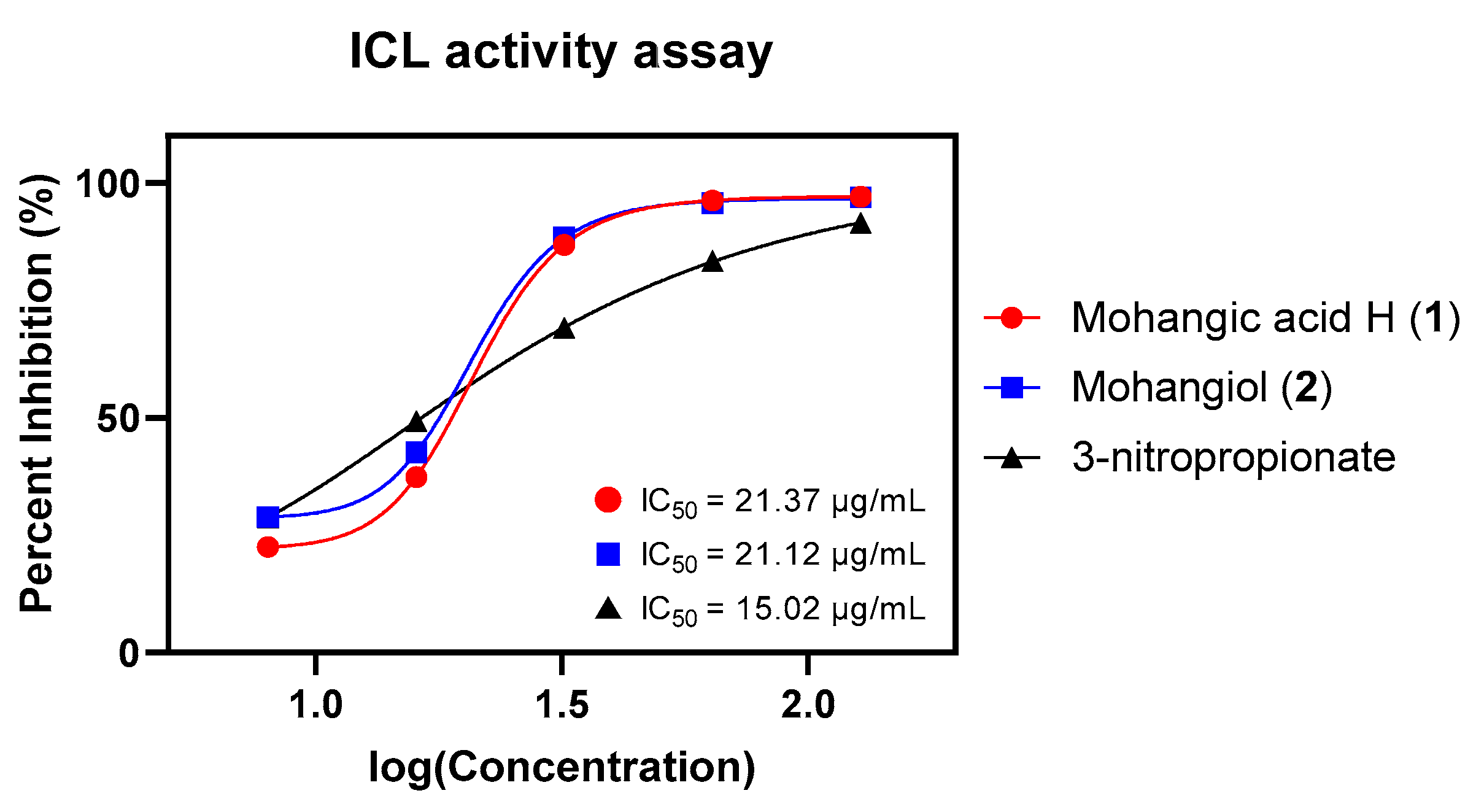
| Mohangic Acid H (1) a | Mohangiol (2) a | |||||
|---|---|---|---|---|---|---|
| No. | δC, Type | δH, Mult (J in Hz) | No. | δC, Type | δH, Mult (J in Hz) | |
| 1 | 171.7, C | 1 | 24.7, CH3 | 1.35, d (6.0) | ||
| 2 | 125.1, CH | 6.39, d (15.5) | 2 | 66.8, CH | 4.05, br. s | |
| 3 | 143.2, CH | 7.71, dd (15.5, 11.0) | 3a | 40.3, CH2 | 1.64, m | |
| 3b | 1.79, m | |||||
| 4 | 145.4, CH | 6.43, m | 4a | 30.0, CH2 | 2.34, m | |
| 4b | 2.41, m | |||||
| 5 | 129.4, CH | 6.45, m | 5 | 132.9, CH | 5.75, m | |
| 6 | 41.2, CH | 2.69, m | 6 | 131.8, CH | 6.22, dd (15.0, 10.5) | |
| 7 | 79.1, CH | 3.5, dd (9.0, 5.0) | 7 | 131.3, CH | 6.28, dd (15.0, 10.5) | |
| 8 | 34.6, CH | 1.95, m | 8 | 136.2, CH | 6.03, m | |
| 9a | 36.7, CH2 | 1.65, m | 9 | 41.2, CH | 2.65, m | |
| 9b | 1.85, m | |||||
| 10 | 37.3, CH | 2.07, m | 10 | 79.8, CH | 3.49, m | |
| 11 | 72.8, CH | 4.62, m | 11 | 34.5, CH | 2.00, m | |
| 12a | 43.2, CH2 | 3.53, dd (15.0, 9.0) | 12a | 37.3, CH2 | 1.70, m | |
| 12b | 3.19, dd (15.5, 3.0) | 12b | 1.88, m | |||
| 13 | 199.7, C | 13 | 37.6, CH | 2.09, m | ||
| 14 | 18.4, CH3 | 1.17, d (6.5) | 14 | 73.3, CH | 4.63, br. s | |
| 15 | 14.7, CH3 | 1.19, d (6.5) | 15a | 42.9, CH2 | 3.19, d (15.5) | |
| 15b | 3.46 (m) | |||||
| 16 | 16.2, CH3 | 1.18, d (6.5) | 16 | 198.7, C | ||
| 17 | 18.9, CH3 | 1.20, d (6.5) | ||||
| 18 | 14.7, CH3 | 1.19, d (6.5) | ||||
| 19 | 16.4, CH3 | 1.21, d (6.5) | ||||
| 1′ | 133.6, C | 1′ | 127.7, C | |||
| 2′ | 130.3, CH | 8.26, d (8.5) | 2′ | 131.9, CH | 8.18, d (8.5) | |
| 3′ | 119.2, CH | 8.08, d (8.5) | 3′ | 114.0, CH | 6.95, d (8.5) | |
| 4′ | 145.1, CH | 4′ | 154.8, CH | |||
| 5′ | 119.2, CH | 8.08, d (8.5) | 5′ | 114.0, CH | 6.95, d (8.5) | |
| 6′ | 130.3, CH | 8.26, d (8.5) | 6′ | 131.9, CH | 8.18, d (8.5) | |
| 4′-NH | 11.13, s | |||||
| 4′-NH2 | 6.61, s | |||||
| 7′ | 169.8, C | |||||
| 8′ | 24.4, CH3 | 2.18, s | ||||
| Sample | 128 µg/mL | 64 µg/mL | 32 µg/mL | 16 µg/mL | 8 µg/mL | IC50 (µg/mL) |
|---|---|---|---|---|---|---|
| Mohangic acid H (1) | 97.01% | 96.22% | 86.76% | 37.35% | 22.49% | 21.37 |
| Mohangiol (2) | 96.89% | 95.68% | 88.29% | 42.54% | 28.90% | 21.12 |
| 3-nitropropionate * | 91.40% | 83.41% | 69.03% | 49.28% | 28.76% | 15.02 |
Disclaimer/Publisher’s Note: The statements, opinions and data contained in all publications are solely those of the individual author(s) and contributor(s) and not of MDPI and/or the editor(s). MDPI and/or the editor(s) disclaim responsibility for any injury to people or property resulting from any ideas, methods, instructions or products referred to in the content. |
© 2025 by the authors. Licensee MDPI, Basel, Switzerland. This article is an open access article distributed under the terms and conditions of the Creative Commons Attribution (CC BY) license (https://creativecommons.org/licenses/by/4.0/).
Share and Cite
Son, J.; Lee, J.H.; Cho, Y.-J.; Moon, K.; Bae, M. Mohangic Acid H and Mohangiol: New p-Aminoacetophenone Derivatives from a Mudflat-Derived Streptomyces sp. Mar. Drugs 2025, 23, 307. https://doi.org/10.3390/md23080307
Son J, Lee JH, Cho Y-J, Moon K, Bae M. Mohangic Acid H and Mohangiol: New p-Aminoacetophenone Derivatives from a Mudflat-Derived Streptomyces sp. Marine Drugs. 2025; 23(8):307. https://doi.org/10.3390/md23080307
Chicago/Turabian StyleSon, Juwan, Ju Heon Lee, Yong-Joon Cho, Kyuho Moon, and Munhyung Bae. 2025. "Mohangic Acid H and Mohangiol: New p-Aminoacetophenone Derivatives from a Mudflat-Derived Streptomyces sp." Marine Drugs 23, no. 8: 307. https://doi.org/10.3390/md23080307
APA StyleSon, J., Lee, J. H., Cho, Y.-J., Moon, K., & Bae, M. (2025). Mohangic Acid H and Mohangiol: New p-Aminoacetophenone Derivatives from a Mudflat-Derived Streptomyces sp. Marine Drugs, 23(8), 307. https://doi.org/10.3390/md23080307







